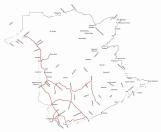1
By 1885 the Canadian Pacific Railway was completed to British Columbia making it the first transcontinental railway in Canada, but the Canadian Pacific Railways still had no way to move freight to the ice free Maritime ports. Instead the Canadian Pacific Railways relied on lines that terminated in the United States to ship goods via the Atlantic Ocean during the winter. In 1882 the president of the Canadian Pacific Railways acquired controlling stock in the New Brunswick Railway Company. The New Brunswick Railway then acquired long-term leases on the following lines during the next decade: the St. Andrews and Quebec Railway, the St. Stephen Branch Railway, the Woodstock Railway Company, the Houlton Branch Railway, and the Saint John and Maine Railway. On September 1st 1890, the Canadian Pacific Railways obtained long-term leases on the New Brunswick Railway line and all of its leased lines. After acquiring the Saint John and Maine Railway in 1883 the Canadian Pacific Railways now only needed to build a 160 mile line from Mattawamkeag, Maine to Megantic, Quebec then the Canadian Pacific Railway would have access to a Maritime port. This line was completed in 1889 and the first trains from Montreal to Saint John began to run. It is interesting to note that because the Canadian Pacific Railways tracks to the Maritimes ran through Maine that meant that American neutral policies prevented troops and supplies headed for the Port of Halifax from using Canadian Pacific Railway lines during the First & Second World Wars, so all those men and equipment had to be moved over the all Canadian Intercolonial Railway route. At last the industries of Western New Brunswick finally had a fairly direct connection with markets in Central Canada. Over the next two decades the Canadian Pacific Railways continued to buy or obtain long-term leases to most of the branch lines in Western New Brunswick including: the Fredericton Branch Railway, the Tobique Valley Railway, the St. Stephen and Milltown Railway, the Shoreline Railway, the Central Railway, and the Southampton Railway. Despite the promise of a more direct route to markets in Upper Canada the Canadian Pacific Railways never did make much money on its New Brunswick routes. Competition from other railways in New Brunswick, all chasing after business from the same small number of manufacturing companies in New Brunswick, and more importantly the growth of the trucking industry meant trouble for Canadian Pacific Railways. Both the McCains and the Irvings, the two largest manufacturers in the Province, operate large trucking companies. By the 1960's Canadian Pacific Railway began abandoning many of the smaller branch lines in the Province. During the 1990's, the two National Railways decided to cut back on rail mileage in New Brunswick and other parts of Canada, so many branch lines nation wide were abandoned. Other still profitable lines which did not fit into the new National Criteria for the two National Railways were sold to various short line companies. By 1995 only the European and North American Railway Company (commonly known as the Western Extension) line and the line from McAdam to St. Stephen were still operating in New Brunswick. Both are now owned by a short line railway known as the New Brunswick Railway.2
Canadian Pacific Railways lines19th Century
New Brunswick, Canada
 Credits:
Credits:New Brunswick Railway Museum